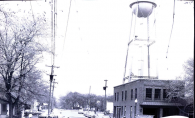The railroad played a significant role in the development of White Bear and the surrounding area. When the Lake Superior & Mississippi Railroad opened its line through White Bear in September 1868, access to the lake area was greatly enhanced. The line was completed to Duluth by 1871, connecting the capital city of St. Paul to the international seaport directly through White Bear.
It is no coincidence that the great resort boom for which White Bear is best known immediately followed the opening of the rail line. The opportunity to take a 20-minute train ride to the lake instead of a three-hour bumpy, dusty wagon ride greatly increased the number of visitors coming from St. Paul and beyond. The resorts boomed from about 1870 until 1910, drawing hundreds of visitors each day.
While ownership of the railroad changed hands over the years, evolving from small lines such as the St. Paul & Mississippi to larger entities like the Northern Pacific, and ultimately, the Burlington Northern Santa Fe, the economic impact on the community continued for many decades. The slowing of the resort traffic transitioned into more of a commuter rail in the early 20th century, providing reliable transportation for those who worked in St. Paul and lived in White Bear.
According to the 1930 census, nearly one out of every five households in the City of White Bear Lake and White Bear Township had at least one railroad employee; in the city alone, the number increased to one out of every four households.
By the mid-1930s, the popularity of the automobile caused a reduction of infrastructure and scheduled trains. At the end of the 1960s, regular passenger service was discontinued; freight service would soon follow.
Sara Markoe Hanson is the executive director of the White Bear Lake Area Historical Society. She will be sharing history thoughts monthly on this back page.
For more information on the history of railroads in White Bear Lake, visit the website here, or call 651.407.5327.









